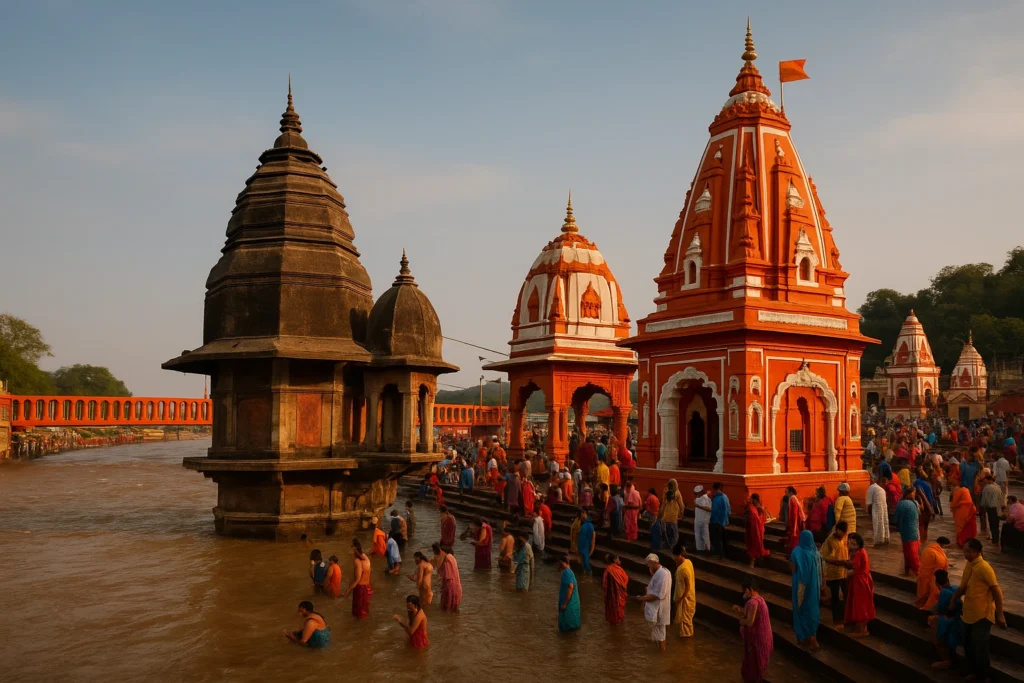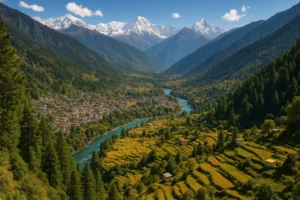India is a land where the sacred hums in the air—carried by the flicker of a diya, the murmur of a river, or the soft chant of a pilgrim’s prayer. For centuries, it’s been a haven for those chasing the divine, a place where the soul finds its echo. The best spiritual places in India aren’t just dots on a map; they’re living stories of faith, woven into the earth’s heartbeat. From the Ganges’ holy ripples to the desert’s quiet song, these places call to anyone seeking meaning.
Below, I’ve poured my heart into a guide to the best spiritual places in India, sharing why they move the spirit, when to walk their paths, and what it costs to stand in their light. This is my invitation to explore the best spiritual places and find your own peace.
7 Best Spiritual Places in India
1. Varanasi, Uttar Pradesh
Why to Visit
Varanasi, one of the best spiritual places in India, feels like the world’s oldest prayer. They call it Kashi, Shiva’s city, where the Ganges flows like a mother’s lullaby. At dawn, pilgrims wade into the river, cupping its waters in their palms, whispering hopes for moksha—freedom from life’s endless wheel. The Ganga Aarti at Dashashwamedh Ghat is a dance of fire and faith, priests swinging lamps as the sky turns violet.
Kashi Vishwanath Temple, its dome kissed by gold, hums with devotion. Wander the tangled alleys, past sadhus in saffron and the scent of sandalwood, and you’ll feel Varanasi’s pulse—wild, holy, eternal. It’s one of the best spiritual places in India for anyone craving a glimpse of the infinite.
Best Time to Visit
Come between October and March (15°C–30°C), when the air is cool and the ghats glow softly in winter’s light. Mornings are perfect for boat rides; summer’s heat and monsoon’s floods are best avoided.
Entry Fees
- Kashi Vishwanath Temple: Free to enter; special darshan tickets cost ₹300–₹500 for a quicker visit.
- Ganga Aarti: Free—just find a spot by the river’s edge.
- Boat Rides: ₹200–₹500 per person, depending on the boat’s size and route.
- Other Ghats and Temples: Free, though a small coin for blessings is welcomed.
2. Rishikesh, Uttarakhand
Why to Visit
Rishikesh, among the best spiritual places in India, is where the Ganges runs wild and free, fresh from Himalayan snows. Known as the yoga capital, it’s a refuge for hearts seeking stillness. In ashrams like Parmarth Niketan, you’ll sit under ancient trees, chanting with strangers who feel like kin. The Beatles Ashram, draped in vines and graffiti, whispers of seekers who came before. Cross the wobbly Ram Jhula bridge, let the river’s breeze tangle your hair, and watch the evening aarti at Triveni Ghat, where lamps float like tiny moons. Rishikesh’s green hills and rushing waters make it one of the best spiritual places in India for yoga, meditation, or just breathing deep.
Best Time to Visit
Visit from September to November or February to April (15°C–30°C) for mild days perfect for riverside musings. Monsoons bring mud, and winter’s chill can bite.
Entry Fees
- Parmarth Niketan: Free entry; yoga or meditation classes cost ₹200–₹1,000.
- Beatles Ashram: ₹600 for Indians, ₹1,500 for foreigners.
- Triveni Ghat Aarti: Free, with a small donation if you feel moved.
- Temples and Bridges: No charge.
3. Amritsar, Punjab
Why to Visit
Amritsar’s Golden Temple, one of the best spiritual places in India, is a golden heart beating with Sikhism’s warmth—service, equality, love. Its dome shimmers in the Amrit Sarovar, a pool that holds the sky’s reflection. Barefoot on smooth marble, you’ll join the langar, where volunteers ladle dal and chapati to thousands, no one turned away. The kirtan’s hymns, sung through day and night, wrap you like a shawl. Beyond the temple, Jallianwala Bagh’s quiet garden speaks of sacrifice. This is one of the best spiritual places in India for anyone seeking a faith that feels like home.
Best Time to Visit
Come from October to March (10°C–25°C) for gentle weather. At dusk, the temple’s glow is pure magic. Summer’s heat is too harsh for lingering.
Entry Fees
- Golden Temple: Free; carry a scarf to cover your head.
- Langar: Free meals for all, served with love.
- Jallianwala Bagh: Free entry.
- Partition Museum: ₹10 for Indians, ₹250 for foreigners.
4. Tiruvannamalai, Tamil Nadu
Why to Visit
Tiruvannamalai, among the best spiritual places in India, is where silence feels like a friend. Mount Arunachala, said to be Shiva himself, watches over the town like a sage. The Arunachaleswar Temple, sprawling and ancient, buzzes with prayers, but it’s the mountain’s caves—where Sri Ramana Maharshi sat in stillness—that hold a deeper call. Walk the 14-km parikrama around Arunachala, especially under a full moon, and feel the world fall away. This is one of the best spiritual places in India for those who seek truth in quiet moments.
Best Time to Visit
Visit from November to February (20°C–30°C) for cool days suited for trekking or temple visits. The Karthigai Deepam festival (November–December) sets the hill ablaze with sacred fire.
Entry Fees
- Arunachaleswar Temple: Free; special darshan costs ₹50–₹200.
- Ramana Maharshi Ashram: Free, with donations gratefully accepted.
- Arunachala Trek: No fee; local guides may ask ₹300–₹500.
5. Pushkar, Rajasthan
Why to Visit
Pushkar, a jewel among the best spiritual places in India, is a desert town cradling a sacred lake and the world’s only Brahma Temple. Its 52 ghats hum with soft mantras, and the lake’s waters are said to wash the soul clean. Join a yoga class in a dusty courtyard or stroll the bazaar during the Camel Fair, where faith and festivity collide in a riot of color. Pushkar’s smallness is its charm, making it one of the best spiritual places in India for quiet reflection and desert magic.
Best Time to Visit
Come from October to March (15°C–30°C) for pleasant days. The Camel Fair (October–November) is a vibrant blend of spirit and celebration.
Entry Fees
- Brahma Temple: Free; a small offering is appreciated.
- Pushkar Lake Ghats: Free to visit.
- Yoga Sessions: ₹500–₹2,000, depending on the ashram.
6. Bodh Gaya, Bihar
Why to Visit
Bodh Gaya, one of the best spiritual place, is where the Buddha found light under a Bodhi Tree. The Mahabodhi Temple, its spire golden against the sky, hums with monks’ chants and pilgrims’ prayers. Its gardens, dotted with ancient stupas, invite you to sit and breathe. Visit the Great Buddha Statue or nearby monasteries to feel the weight of centuries-old wisdom. Bodh Gaya is known for those seeking peace through meditation or Buddhist truths.
Best Time to Visit
Visit from October to March (15°C–28°C) for comfortable weather. Buddha Jayanti (April–May) brings joyful crowds, but it’s warmer.
Entry Fees
- Mahabodhi Temple: Free; camera fees are ₹100–₹200.
- Monasteries: Free, with donations welcomed.
- Meditation Centers: Some charge ₹200–₹1,000 for sessions.
7. Auroville, Tamil Nadu
Why to Visit
Auroville, a unique star among the best spiritual places in India, is a township born from a dream of human unity. The Matrimandir, a golden dome cradled by gardens, is a quiet space for meditation, free from ritual or creed. Here, people from every corner of the world build a life rooted in harmony and care for the earth. Auroville is one of the best spiritual places in India for those seeking a new kind of spirituality—open, modern, and shared.
Best Time to Visit
Visit from November to March (20°C–30°C) for mild days. Summer’s humidity can weigh heavy.
Entry Fees
- Matrimandir: Free for meditation, but you must book ahead.
- Visitor Center: Free to enter.
- Workshops: ₹500–₹3,000, depending on the offering.
Best Places to Travel in June in India
FAQs
- Why is India so special for spiritual seekers?
India’s ancient traditions, sacred rivers, and diverse faiths create a unique spiritual landscape. Places like Varanasi and Bodh Gaya offer rituals and settings that resonate with the soul. - Do I need to follow a religion to visit these places?
Not at all. Sites like the Golden Temple and Auroville embrace everyone, focusing on universal values like peace and unity. - Are these destinations safe for solo travelers?
Yes, especially in peak seasons. Rishikesh and Amritsar are welcoming, but stay cautious in crowded areas or at night. - What should I wear at sacred sites?
Wear modest clothing covering shoulders and knees. For gurudwaras, a headscarf is essential. Light, breathable fabrics work best. - Are accommodations available near these places?
Absolutely. Options range from budget guesthouses (₹500–₹2,000/night) to upscale hotels (₹5,000–₹15,000). Ashrams offer affordable stays. - Can foreigners join rituals or meditation?
Yes, many centers in Rishikesh and Bodh Gaya welcome foreigners. Some require registration or small fees for classes. - How do I plan a spiritual trip to India?
Choose 2–3 destinations, visit during cooler months, and book stays early. Local guides can deepen your experience of rituals and history.
Conclusion
India’s spiritual destinations are like lanterns guiding you inward. Whether it’s the Ganges’ sacred flow in Varanasi, the meditative hush of Bodh Gaya, or the communal warmth of Amritsar, each place offers a unique thread in the tapestry of self-discovery. Affordable entry fees and the inviting weather from October to March make these journeys accessible. These sites aren’t just about faith—they’re about feeling the pulse of something greater. Pack light, carry an open heart, and let India’s sacred spaces weave their magic into your soul.






